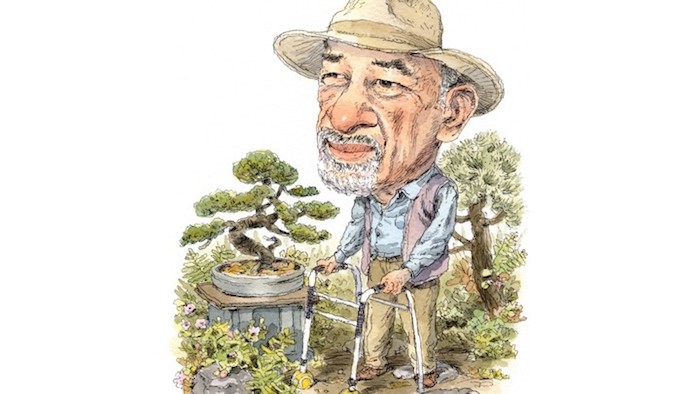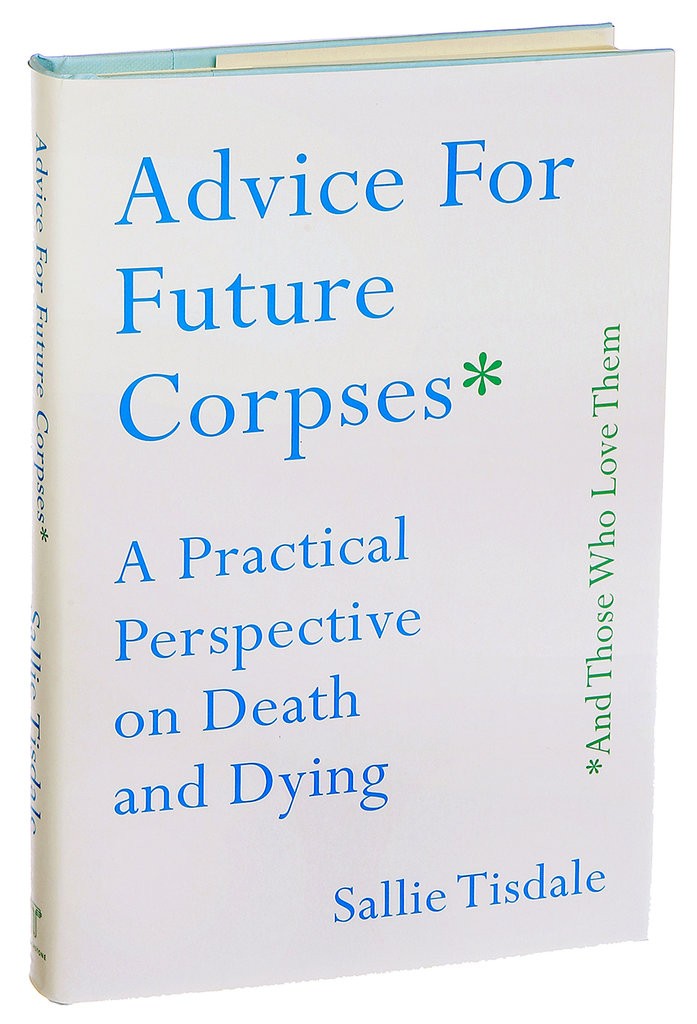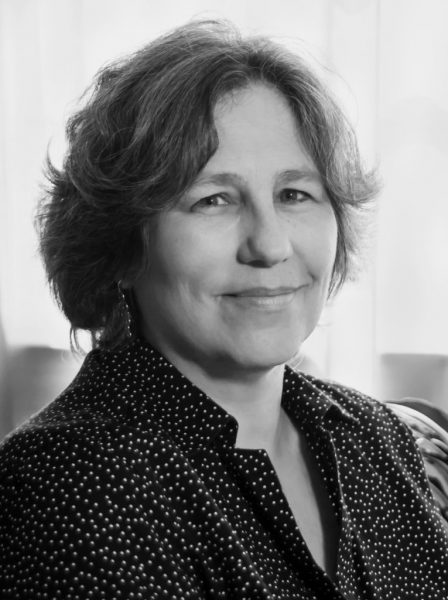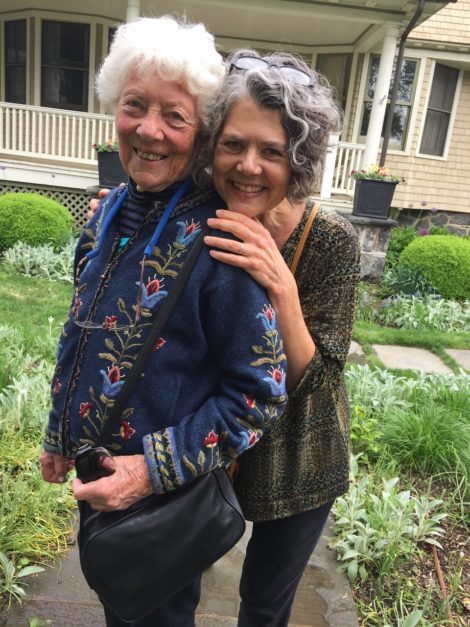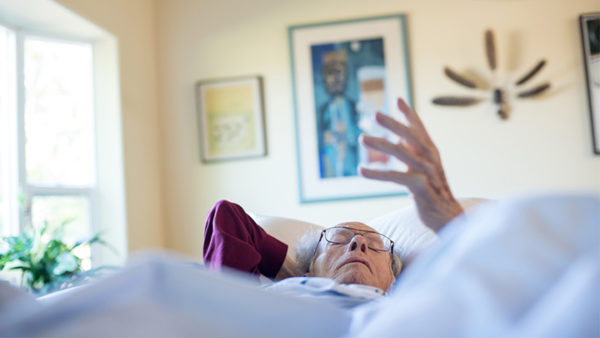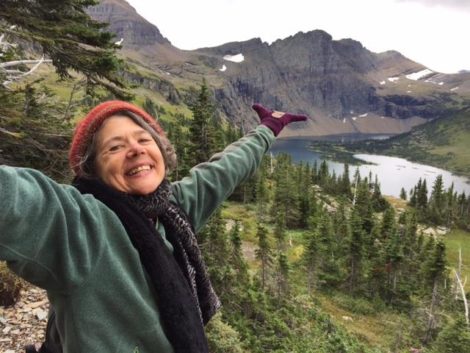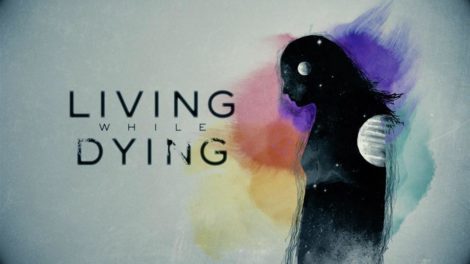An interview with Sallie Tisdale, death and dying educator
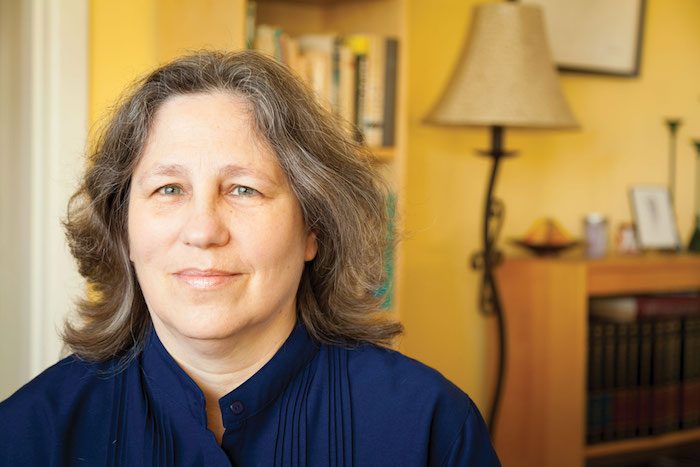
“I have never died, so this entire book is a fool’s advice,” writes Sallie Tisdale at the start of her latest work, Advice for Future Corpses (and Those Who Love Them): A Practical Perspective on Death and Dying. However, there’s wisdom in knowing that you don’t know it all, and Tisdale’s enchanting prose searches as often as it instructs. In addition to being a writer, Tisdale is a Buddhist practitioner and teacher, a nurse, and an end-of-life educator who leads workshops on preparing for death; her depth of experience at the side of the dying is apparent throughout.
In these essays, Tisdale tells of the death of her Zen teacher, her mother, her close friend Carol, and others she has known, and asks questions many of us avoid: How do we define death? How do we manage physical pain or grief? Does our dignity depend on our health? This book, Tisdale writes, is meant to help you prepare for your own death and the deaths of those closest to you. It’s a travel guide to the end of life, a map of the territory, not a book of spiritual guidance. At its close, Tisdale even offers four appendixes for those seeking advice on the practicalities of death preparation. “My Death Plan,” “Advance Directives,” “Organ and Tissue Donation,” and “Assisted Death” prompt readers to consider their preferences for pain management, rituals and services, burial place, funerary rights, and more.
“If you die once, you will never have to die again,” Tisdale told Tricycle in February, recalling a teaching she heard when she was a young Zen student. At the time, she found the sentence perplexing. But as her practice progressed, the deep sense of release that she experienced—a “falling away of body and mind”—encouraged her to continue, and eventually led to the understanding that one can meet death as wholly as one aims to meet life. In the interview that follows, she tells Tricycle how she cultivated familiarity with her own mind while tending to her patients and loved ones, and why considering our own death just might make us happier.
—Marie Scarles, Associate Editor
Why did you feel compelled to write this book? I’ve been leading workshops and small groups about preparing for death at my Zen center for about a decade. I started to hear that people in other groups wanted to see the syllabus and material I was using. So I thought I could develop it into something that would be comprehensive and useful for people.
Preparing oneself to die is an inescapable challenge. It is also part and parcel of religious practice. I’m struck by the fact that as Buddhists we know this and yet it doesn’t come up in conversation all that often. We self-censor. We think, Oh, if you were a really good Buddhist you wouldn’t have those feelings, you’d wouldn’t have that fear, you wouldn’t be confused, you wouldn’t be struggling. You’d have it all figured out. This is very damaging to us. Our practice is about authenticity, rigorous self-examination, and honesty. If we’re honest, we’re going to admit that none of us is quite ready to die.
In the book, you write that when we’re speaking with someone who is dying, we need to avoid telling them what they should do or how they should feel. Are these “shoulds” another form of censorship? I’m going through this with a friend right now. I was with him last night, and one of the things that he’s really struggling with is his deep fear of self-extinction. I have to bite my tongue not to try to reassure him, not to try to take the fear away from him, but to let him explore it and feel it. It’s his, and his perspective on it is very different from mine. It’s not my life.
It’s so easy for us to pop in and say, “You should be feeling this,” or “Of course, you want me to do and say this.” But when we do, we’re missing the fact that nothing is more intimately the result of your whole life than how you meet death. We have to notice our urge to put our own veneer on someone else’s experience.
I’m sure I’m less uncertain and awkward than most of the people in the room, but I am still awkward and uncertain at times at that bedside: I’m not sure how to answer a question, or I’m looking for comfort with the silence, knowing there’s nothing to be done about certain things. I’m still just trying to meet the experience all the time, and stuff comes up for me, of course. It does for all of us. But it’s really myself that I’m encountering, the ways I think it should be. This is the way I want it to be for me. That fundamental egotism is still there, even at somebody else’s deathbed. You have to continually notice this fundamental egoism.
I imagine this process of getting to know your own experience—as well your nursing work—has helped you navigate encounters with death. Of course, every death is different. Yet there are remarkable similarities. We’re not that different from each other. You can really predict and expect certain things with the deaths from chronic illness. Even with sudden deaths, once the moment of death is reached, it’s the same moment. It’s something you recognize if you’ve seen it before. It’s like that line in the Theravada version of the Mahapari-nirvana Sutra where Ananda says that the hair on the back of his neck stood up when the Buddha died. There’s something we recognize there that goes really deep.
I also want to say that I had a lot of fun writing this book. I feel a lot of joy in the face of the preciousness of life—a kind of silly joy at times. Not only are there these rituals of crying and role change that every culture has around the deathbed, there’s also a deep worldwide culture of laughing at death, making fun of it, joking about it. I think it’s because it puts us face-to-face with the deep love that we feel for each other.
This reminds me of a 2007 study you mention in the book that says thinking about our death makes us happier. Yes, but they explained this happiness in a different way. They’re talking about terror management theory—the psychological belief that it is fundamental to human nature to be terrified of death and that you can’t escape the terror. Terror management theory states that you can’t not be afraid of death. I don’t believe that. I think we are all afraid of it until we know it. When we really know it, that’s what spares us from the terror. Terror management theory says that this is part of being human, and that we do a tremendous number of things to distract and protect ourselves from this fear. I think we’re healthier than that. In the Buddhist sense, we have the potential to be as healthy and whole around this as around everything else in our life.
An awareness of death comes and goes. We’re hyperaware of it at one moment, maybe when someone close to us is dying, and then it fades away again. How do we get to know death, or maintain this sense of awareness? I’m a Zen practitioner, so the language I’d use here is “the falling away of body and mind.” If we become familiar with what it means to arise and fall in every moment, if we become familiar with the emptiness of the purported self and we come to accept ourselves as a loosely cohering set of compounded things, we don’t believe in the self all the time. Of course, we constantly forget and remember this again, but over time we do become more familiar with ourselves as impermanent, and eventually we come to see the glory of that. The grace of impermanence is that we belong to everything, that we are not separated from anything, that we are not isolated. As I say in the book, we may be waves on an ocean, but we are waves that know we are waves. That’s what I mean by really getting to know death. It’s not just spending time at a bedside, being with people who are facing death, getting to know your reactions to it. In a practical sense, this can be very helpful. But the most effective thing in getting to know death isn’t being with dying people, but sensing myself as being a continually dying person.
There’s a saying I’ve been told as long as I’ve been practicing: “If you die once, you will never have to die again.” I heard that when I was very young, and I didn’t know what it meant, but I do now. When I first experienced the falling away of body and mind, even a tiny bit, it was as though I had been a tightly wound spring, and I thought, I’m going to continue to unwind forever. There was such relief and relaxation and peace in the realization that this constriction would keep letting go. I could just look forward to more and more relaxation. Throughout my life I have continued to feel that spring unwind, a little bit at a time. We have as many lifetimes as we need to get there. [Laughs.]
Still, I will feel afraid when it’s my time, when I get that bad diagnosis and I’m on that doctor’s table. I’m sure there will be resistance and fear. So let’s admit it: The resistance is there. The denial arises. Admit that. But there will also be curiosity and wonder at the point of facing death, just because I have looked at it enough.
Your experience as both a dharma teacher and a nurse comes through in the book: you’re writing from the perspective of someone who has witnessed countless deaths. Yes, but that doesn’t mean that I don’t feel uncertainty and awkwardness as well. We bring our whole self there. It’s significantly easier for me to do this with a client than a friend.
When my mother was dying, my siblings looked to me like, Well, you can take care of her. And I had to say, No. I’m the daughter here. I have to be the daughter here. Sometimes, no matter how much practical experience you have, you have to bow to the fact that this is not your role this time. You need to be the daughter or the mother or the friend. Most of us will lose some friends, our parents, our siblings—but not that often. So it’s always okay to be who we are in these moments. It’s always okay to have the weaknesses and the confusion and the questions that we have. It’s always all right to just say, “I don’t know. I’m not sure. I’m scared. I’m worried. I’m afraid of this. I’m not sure what to do next.” It’s okay for all of those feelings to be there. We really will trip ourselves up if we think we have to have it all together.
I was thinking about this last night while sitting at the bedside of my friend, someone I’ve known for 40 years. He’s really scared to die. We learn in our practice to deal with our own suffering. We learn to recognize other people’s suffering, and we learn to see the sources of suffering. But it’s really hard to learn that you can’t take somebody’s suffering away from them. It’s important that we remember the bodhisattva Guanyin, she who hears the cries of the world. She’s the witness; she’s not fixing everything all the time—she is just seeing it. There’s so much we can do for each other, but we can’t do it all. It’s not possible to entirely comfort and console another person. They have—we have—to feel pain. It is part of this life.
Caretakers’ Dos and Don’ts
An excerpt from Advice for Future Corpses (and Those Who Love Them)
If you are dying, you can say anything you want. You can say it when you want, and to whom you want. And you don’t have to say anything at all. Most of what I offer here is for the visitor, the companion, the helper. You have to follow some rules.
Think about how you explain ordinary information: the washing machine is on the fritz, we’re out of milk, I got a parking ticket today. Then think about how you communicate more urgent news: I wrecked the car. The power’s out. It’s different. Consider how you react in an argument. That’s different, too. Do you shut down, stop thinking? Do you start to cry or yell or leave the room? We all have a pattern for difficult conversations. If you are going to spend time with a dying person, know how you handle emotional scenes. What scares you? What makes it easier? Make a list. Practice!
Listening isn’t that complicated. It’s hard, but it’s not complicated. Few of us communicate really well. We think explaining ourselves is key, but listening is the most important part. Half the energy of caring for a dying person is listening, really listening. We are driven to think of ourselves first, and spend half the time appearing to listen while we prepare what we are going to say when it is our turn to speak. So: Listen. Say: This sounds very difficult. Say: I can tell how much thinking you’ve done about this matter. Say: Um-hmm. Tell me more. Keep bringing your mind back to the present moment when you stray. Invite detail. Ask questions and make it clear that you want to know. Anxiety makes it difficult to remember information, so repeat yourself if necessary. Speak in a calm and unhurried way. Reflect what you’ve heard, because you might have heard wrong: It sounds like you are saying you are afraid. Clarify, because you might have heard wrong: Let me make sure I understand. I think you are saying . . . If you can do these things, you are almost there. Be calm. Be nonjudgmental. Repeat.
If you are spending time with a person who is dying, you become a protector. You are the defender of modesty, privacy, silence, laughter, and many other things that can be lost in the daily tasks. You are the guardian of that person’s desires.
You will become a gatekeeper. Everyone needs a gatekeeper! Be the one who can say with a smile, Goodbye, Aunt Lucille. The one who can reach out a hand to the visitor and say, Time to go. We’ll call when we’re ready for another visit! while walking to the door.
Visitors come in many forms. Lots of friends will just drop in for a cup of tea and a few innings of the baseball game and take the garbage out when they go. Hurray for those friends. But you may also meet what the writer Glennon Doyle Melton calls the Fixer. This is the person who is certain that my situation is a question and she knows the answer. The Fixer is on the edge of her seat, ready with the solution. Melton went through a difficult breakup, and so she also knows the Comparer: the visitor who only appears to listen, who is just waiting for the chance to explain how his experience, or his nephew’s experience, or his aunt’s boyfriend’s cousin’s experience, compares to yours. Sooner or later a visitor arrives with what I think of as one-downmanship: the person with the sad face who spends their entire visit explaining why their troubles are worse than yours.
Set boundaries—for visitors, but also for yourself. Start with setting the boundaries for the visit, and do this every time. Say, I can stay for an hour, or I’ll be here until dinner, when Mary arrives. Before you leave, tell the person when you will be back. This removes the uncertainty, the unbounded edges that can make for a stressful conversation. A boundary gives both of you a space in which to be together. If you’re going to be coming regularly, you might offer a frank contract: when you will be there, for how long, to do what. If you can’t stand daytime television, can you watch Days of Our Lives anyway? If you don’t like cigarettes, can you sit easily with someone who smokes? Don’t say: I told you to quit smoking.
There are lots of ways to help besides making soup and sweeping the floor. (Those are often good things to do.) You can help people write letters or arrange a meeting. Offer to buy groceries or do the laundry, drive to an appointment or organize the bills. Offer only what you can deliver: I will stay with you through the night, or I will mail these letters for you. Be specific. (Then do what you say you will do. Not to put too fine a point on it, but you only get one shot at this.) Write all these things down and put it on the refrigerator. Your friend has enough to remember without keeping track of the calendar. Don’t say: Be sure to keep me posted.
Ask permission for everything. Be aware that you have the power here. (Be willing to discuss this fact.) Ask permission until your friend says, Quit asking for permission. Ask if a person wants to talk before you plunge in with the news of the day. Would they rather listen to music or play checkers or watch The Walking Dead? Do they want to take a shower? Do they want to eat something? If so, be clear. Vanilla or chocolate ice cream? is easier to answer than Is there anything you want to eat? Always ask for permission, but give permission, too. Permission to be sad, to be angry, to be sleepy or bored. To be something other than dying. To die.
Ask about privacy and confidentiality, favorite foods, how they want the room to be set up. Lights up, or down? Door open or closed? Music on or off? Agree on a signal for ending the visit. Know when to leave. Know when to be quiet.
You have to be honest with the dying person, but above all with yourself. There is nothing else worth doing here. Honesty is generosity, because when you are honest, you offer what you can truly give. Be honest about your own emotional state, without burdening the sick person. Resist your own impulses, your need for consolation, your wish for power, your urge for denial.
Know your limits. You have to grieve, and that means you have to go away sometimes. If you are hungry or need a rest, take care of yourself. If you’re anxious or worried, admit it. (Just don’t ask your friend to fix your feeling.) There’s a tricky balance between keeping your feelings in check and being authentic. You may try to downplay things, especially tears and anger, but you don’t have to hide them completely. On the other hand, you may be surprised by jealousy, irritation, and loneliness, and these are really yours to sort out elsewhere. Don’t say: Why didn’t you call me first? Why did you tell her before me?
Knowing these things is half the battle. The other half is watching and working with what happens.
A person who is ill may try to trigger your reactions. People may be testing whether you can handle talking about a difficult subject. Good listening goes a long way toward showing acceptance, and so does an open posture. Don’t stand over a person in bed or bustle around when they’re talking. Settle down, relax, keep your posture open, and try not to touch or soothe the difficulties away. You might feel a powerful urge to soothe painful feelings, to cover up. Don’t change the subject.
If there is a topic you absolutely cannot discuss, make that clear. Can you be still while a person cries? Don’t put a person in the difficult position of upsetting his caregiver. Don’t hide all your feelings under a bushel, but be a grown-up and manage your grown-up pain.
A person overwhelmed with illness may displace difficult feelings and shift attention away from the problem she is afraid to face. The big problem at hand. The ego is often about seven years old and prone to distractions when uncomfortable, like a kid who spills his milk just as you ask whether his chores are done. Adaptation takes many forms. Some people rationalize destructive behavior, ignore consequences. Some people will regress under stress, reverting to behaviors they used when they were much younger, refusing to take responsibility and looking for another person to act as the adult. There’s nothing inherently wrong with that; we all like someone else to be the adult sometimes. Just notice if it’s a pattern, and be careful. Watch the urge to become parental under stress, to take charge and try to manage the situation. Taking charge protects you from having to feel hopeless, but may not be what the person really needs.
Balance affect. If the person is hurried and talkative, you can speak slowly and listen. If they are withdrawn, you can start by doing the talking. If they are pacing, sit still. Notice incongruence. Is the person smiling while they tell a sad story? Are they clenching their fists while they say everything is fine? Dying tends to create incongruent feelings. You don’t have to challenge this. The person is working things out. Just be congruent in yourself. Don’t be afraid to cry a little sometimes; that’s congruent.
One way I might manage the hardest parts of being sick is to intellectualize my feelings. Perhaps I talk about the kind and brand of walker I want and ask you to check on prices. But I never say how it feels to need a walker (or a burial shroud). I may complain about how long it takes you to bring me lunch because I don’t want you to notice that I need help getting up from my chair. I don’t want to notice it, either. If I get angry at you for being late, I can briefly forget how it feels to need your help in the first place. Humans deflect when things hurt, and we are quick to project our struggles onto other people, using another as a kind of surrogate. I may talk about how Uncle Mario needs to use a walker now. I’m not just distracting you; I’m also testing you. I’m learning important information about how you feel about people who need walkers.
What not to say: Don’t talk like that. Let’s just talk about something happy. One of the most common ways we defend ourselves is by denial. We may simply deny what we’ve been told is true. Things not to say: My mother’s biopsy was negative. You look fine. Are you sure you’re sick? Denial is normal, but notice your own. A dying person may deny the truth for a long time. How often do we deny another’s denial? How often do we try to drag a person to the place where we think they should be, instead of meeting a person where he or she is? This is where open-ended responses help so much. Reflect on what you hear. Ask for more detail. Ask for what it means. Listen.
♦
From Advice for Future Corpses by Sallie Tisdale. Copyright © 2018 by Sallie Tisdale. Reprinted by permission of Touchstone, an imprint of Simon & Schuster, Inc.
Complete Article ↪HERE↩!

